Snowmobiling in the mountains offers an exhilarating mix of speed and scenery. There’s nothing quite like slicing through fresh powder with a backdrop of majestic peaks. This blend of adrenaline and tranquility is what draws many thrill-seekers to mountain snowmobiling.
For the ultimate experience, venturing into snowmobiling hotspots like Yellowstone, the Colorado Rockies, or the Canadian Rockies is a must. Each destination boasts unique trails and landscapes, offering something for both beginners and seasoned riders. Exploring these areas provides the chance to witness some of the most beautiful winter vistas on the planet while enjoying the sport.
Preparation and skills are crucial for a fun and safe snowmobiling adventure. This includes not only knowing how to operate a snowmobile but also understanding the mountain environment and weather conditions. A few essential skills include reading the terrain, understanding avalanche safety, and being capable of basic mechanical snowmobile fixes. Even with these skills, always consider weather conditions and the potential for rapid changes—mountain weather can be unpredictable.
Before heading out, ensure that you have all the necessary gear: a reliable snowmobile, proper clothing to protect against the cold, a helmet, and essential tools and safety equipment. Being well-prepared can make all the difference, turning a potentially dangerous situation into just another memorable chapter in your snowmobiling adventure.
The Role of GPS in Mountain Snowmobiling
GPS technology has become a significant asset for snowmobilers exploring mountain trails. Offering precision and real-time tracking, GPS systems help navigate safely through unfamiliar or complex terrains. As you venture deeper into the backcountry, having a device that points you precisely where you need to go can be invaluable.
Understanding how GPS functions in mountainous areas is vital. Mountains can affect GPS signals because they block satellite connections, leading to discrepancies in positioning. Selecting the right GPS device can enhance your experience, with newer models offering better satellite coverage and improved accuracy even in challenging conditions.
The advantages of GPS in these settings are clear: it helps avoid getting lost and can guide you quickly back to safety if the weather turns or if you veer off course. Additionally, some GPS devices offer features like route tracking, which allows you to backtrack or share your adventure with friends.
While GPS is beneficial, it’s crucial to recognize its limitations in the mountains. Dense forests and narrow valleys may disrupt signals, so it’s essential to understand when and how this might happen. Choosing a GPS designed specifically for outdoor adventures can mitigate some of these issues, but no device offers a fail-safe solution in complex terrains.
Accuracy of GPS in Mountainous Terrain and Wooded Areas
When it comes to using GPS in mountainous and heavily wooded areas, accuracy can be a hit or miss. The rugged terrain and dense forests pose challenges for GPS devices in maintaining reliable satellite connections. This means that at times your coordinates might be off, leading to potential navigational errors.
Several factors influence GPS accuracy in these environments. Weather conditions, such as heavy snow or thick cloud cover, can disrupt signals. Additionally, the physical geography—think jagged cliffs and deep valleys—can interfere with the line-of-sight necessary for accurate signal transmission.
In practical terms, this means you should take GPS readings with a pinch of caution. While it’s great for general directions, the margin of error might increase when precision is necessary, especially while on unfamiliar or complex trails.
Real-world experiences show varied results. Some snowmobilers report seamless adventures using GPS without hiccups, while others face moments where GPS leads them slightly astray. Such instances highlight the importance of not entirely relying on technology alone in these scenarios.
Having a backup plan is wise. Relying solely on a GPS in isolated, rugged landscapes might lead to unexpected detours. Being prepared with additional navigation tools and knowledge ensures your snowmobiling outing remains safe and enjoyable.
Why You Need Paper Maps and a Compass as a Backup
Relying solely on GPS while snowmobiling in mountain terrain isn’t always a foolproof plan. Battery life runs out, devices get damaged, or signals fail. Here’s where the trusty paper map and compass play a crucial role.
Technology has gifted us with brilliant tools, but nothing beats the reliability of a paper map when tech falls short. They don’t glitch or run out of power and, when used right, provide clear guidance even through the thickest snow-laden woods and narrow mountain passes.
A reliable compass paired with your map allows you to understand and follow directions without any electronic assistance. In a pinch, understanding basic compass readings might be your best route out of a tricky situation. Plus, maps often give a broader view of the terrain, something digital screens might not provide as efficiently.
Learning to effectively use these traditional tools requires some practice, which pays off in real-world situations. Workshops or online tutorials can boost your skills, ensuring you’re prepared for any challenge snowmobiling throws your way.
Having both technological devices and traditional methods at your disposal enhances safety. This dual approach ensures that if one method falters, you’re not left stranded. Embracing this preparation ethic can greatly impact your overall snowmobiling safety.
Combining Technology with Traditional Navigation for Safety
Balancing modern navigation tools with traditional methods is a smart strategy for any snowmobiler tackling the mountains. GPS devices offer significant help, but pairing them with map and compass skills covers all bases.
Integrating these methods ensures you’re prepared for any navigation challenge. Start by familiarizing yourself with both systems. Practice using your GPS to fine-tune your location and review your maps to chart general paths beforehand.
Safety courses are invaluable for honing these skills. They teach how to interpret GPS data in conjunction with tangible map details, giving you the flexibility to follow your planned routes or adapt should circumstances change.
Creating an emergency plan beforehand is another layer of safety. Know potential shelter locations, emergency contact points, and marked trails that are usually safer. Determine what to do if GPS fails or routes become impassable due to weather.
This hybrid approach to navigation not only boosts confidence but also fosters self-reliance on your snowmobiling expeditions. Being able to switch seamlessly between tech and traditional ensures a richer, safer adventure for all skill levels.
Adventuring Responsibly in the Snow-Capped Mountains
Snowmobiling across mountain landscapes is more than a thrilling escapade; it’s a chance to connect with nature while honing skills and fostering an adventurous spirit. With great opportunities come responsibilities, especially in environments as unpredictable as the mountains.
It’s important to equip oneself with knowledge and respect for the environment. Following marked trails, understanding local wildlife habitats, and minimizing impact all play a role in preserving these pristine areas for future enthusiasts.
Sharing knowledge and experiences with the snowmobiling community enriches personal experiences and enhances collective safety and awareness. Exchange tips on navigation, gear, and safety with fellow riders to build a common understanding informed by a wealth of diverse perspectives.
Finally, always remember the core principles of preparation and precaution. Carry the right gear, respect nature, and acknowledge both the potential perils and pleasures of mountain snowmobiling. By embracing technology and traditional navigation methods, you safeguard your journey, ensuring your mountain adventure is exhilarating and safe.
As an Amazon Associate I earn from qualifying purchases.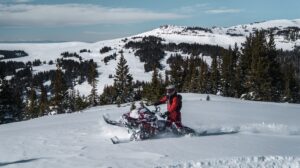
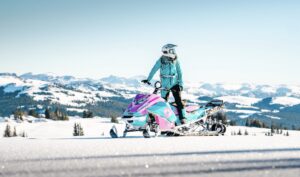

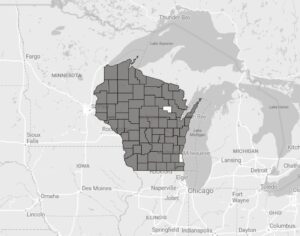
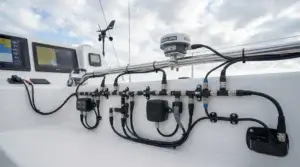
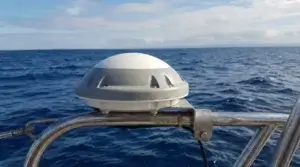
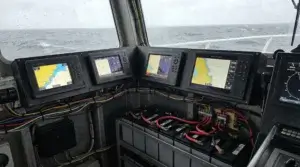
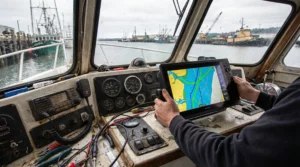
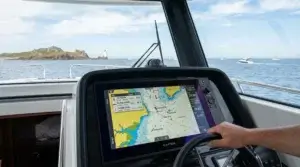
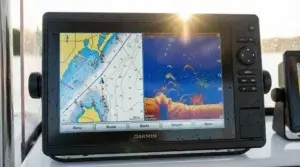

I can only imagine how cold it could be there at the mountains based on these pictures. As someone born and raised in a flat place, I have no experience with snow or high mountains. When I first visited Kenya in 2005, I saw a mountain for the first, but people call it a hill, not a mountain as such.
What are some of the common challenges in going out into the cold places especially for someone inexperienced like me? I’m curious to know. And what is your advice for me in case I happen to travel there sooner or later in life?
John
Thanks for sharing your experience! Seeing mountains for the first time must have been such a memorable moment—especially coming from a flat area. Cold and snowy places definitely bring their own set of challenges, especially if you’re not used to them.
Some common challenges include staying warm enough, dealing with slippery surfaces, and acclimating to the altitude if you’re heading to high elevations. For someone inexperienced, layering is key: wear thermal underlayers, an insulating middle layer, and a waterproof outer layer. Don’t forget gloves, a hat, and sturdy, insulated boots with good traction for snow or ice.
If you plan to visit a high-altitude area, it’s important to take it slow to avoid altitude sickness. Hydration and rest are your best friends! And always check the weather forecast before heading out—conditions can change quickly in the mountains.
If you do get the chance to travel, take it! Cold places can be breathtakingly beautiful, and with a little preparation, you’ll be able to enjoy them to the fullest.”
This piece captures the thrill and adventure of snowmobiling in mountainous terrains beautifully. One often-overlooked aspect is the importance of understanding avalanche safety and terrain navigation. While the thrill of snowmobiling is undeniable, the ever-changing snow conditions in mountain environments require a solid grasp of snow science and topographical awareness to ensure safety.
Beyond the technicalities, snowmobiling presents an intriguing blend of human ingenuity and environmental interaction. It’s fascinating to think about how the evolution of snowmobile technology—like lighter frames, enhanced suspension, and even hybrid engines—has not only expanded accessibility but also reshaped the relationship between riders and these remote, rugged landscapes.
There’s also the cultural aspect. Snowmobiling isn’t just a sport or activity; it’s deeply tied to traditions in many mountain communities. It serves as both a recreational pursuit and a practical means of winter transportation. This duality raises a unique discussion about how snowmobiling can preserve cultural heritage while also embracing modern recreational trends.
Finally, as sustainability becomes a pressing concern, the conversation around eco-friendly snowmobiles is gaining momentum. Can we imagine a future where snowmobiling remains thrilling but also carbon-neutral, using innovative fuels or fully electric engines? Such advancements could redefine the sport for future generations while preserving the pristine mountain environments that make it so exhilarating.
Thank you for such a thoughtful and comprehensive comment! You’ve touched on several important aspects that truly enrich the conversation around snowmobiling.
I couldn’t agree more about the critical role of avalanche safety and terrain navigation. These are essential skills for anyone venturing into mountainous terrain, whether for recreation or practical purposes. The dynamic nature of snow conditions highlights the need for continuous learning and respect for the environment.
Your point about the evolution of snowmobile technology is fascinating. The advancements in design and engineering not only make the sport more accessible but also allow riders to explore areas that were once unreachable. It’s amazing how these innovations enhance the connection between humans and nature, enabling us to interact with these breathtaking landscapes in new ways.
The cultural dimension of snowmobiling is another compelling aspect. In many mountain communities, it bridges the gap between tradition and modernity, serving as both a lifeline and a source of joy. This blend of utility and recreation offers a unique lens through which we can appreciate the sport.
Lastly, the emphasis on sustainability is incredibly timely. As the push for eco-friendly solutions gains traction, imagining a future of carbon-neutral or fully electric snowmobiles is exciting. Such developments could revolutionize the sport, ensuring it remains both exhilarating and harmonious with the natural world.
Thank you for bringing these nuanced perspectives to the discussion!
What a fantastic read! You’ve captured the excitement of snowmobiling in the mountains so well, and I love how you’ve also stressed the importance of staying prepared—it’s such a good reminder that safety and fun go hand in hand.
I’ve definitely had moments when my GPS struggled in wooded areas, and having a paper map and compass made all the difference. Do you have any favorite tips for picking the right GPS or backup tools?
I also really liked your section on responsible adventuring—it’s so important to respect the environment while enjoying it. Do you think most snowmobilers are aware of how they can minimize their impact, or is this something we all need to talk about more?
Thanks for sharing such helpful insights. It’s inspired me to double-check my gear and brush up on my navigation skills before my next trip. Can’t wait to hit the trails!
Thank you so much for your thoughtful comment! I’m thrilled you enjoyed the post and found it helpful—it means a lot to hear that it resonated with you. 😊
I completely agree about the importance of having a paper map and compass as a backup. GPS devices can be fantastic, but they’re not infallible, especially in dense wooded areas or when battery life becomes an issue. When choosing a GPS, I recommend looking for one with strong signal reception, long battery life, and offline map capabilities. A rugged, waterproof design is also a must for snowy conditions. For backup tools, a simple baseplate compass and a detailed topographic map are essentials, and it’s always worth practicing using them before you need them.
I’m so glad you appreciated the section on responsible adventuring! It’s an ongoing conversation we all need to have, and while I think awareness is growing, there’s always room to do more. Many snowmobilers are conscientious, but it’s crucial to continue spreading the word about things like sticking to designated trails, avoiding sensitive wildlife habitats, and leaving no trace. The more we share these practices, the more they’ll become second nature for everyone in the community.
It’s fantastic to hear that this inspired you to double-check your gear and refresh your navigation skills. That’s such a smart step before any adventure—preparation really is the key to both safety and fun. Wishing you an amazing time on the trails, and I’d love to hear about your next trip! Stay safe and enjoy every moment out there. ❄️🏔️
Great article on snowmobiling in the mountains! I have a question and thoughts:
How do you prepare your snowmobile for high-altitude rides, and what maintenance tips do you have?
Snowmobiling in the mountains sounds like an exhilarating experience! The combination of beautiful landscapes and the thrill of riding through the snow is undoubtedly appealing. It’s also interesting to consider the different challenges that mountainous terrain can present, from weather conditions to navigating through rugged areas. Snowmobiling offers a unique way to explore the great outdoors during winter. Your article does a great job highlighting the excitement and challenges.
Thanks for the informative post!
Thank you for your thoughtful comment and kind words about the article! I’m glad you enjoyed it. Preparing your snowmobile for high-altitude rides is crucial for both performance and safety. Here are some tips:
Preparing Your Snowmobile for High-Altitude Rides:
Adjust the Clutching and Jetting: High altitudes have thinner air, which can impact your snowmobile’s engine performance. Recalibrating the clutch and adjusting the carburetor jetting (if applicable) will help optimize power delivery.
Fuel and Air Mixture: Ensure your snowmobile is set up for the altitude to prevent running too rich or too lean. Many newer models automatically adjust with electronic fuel injection (EFI), but older models may need manual tuning.
Inspect the Cooling System: At high altitudes, snow conditions can vary. Make sure your cooling system is in excellent shape to prevent overheating.
Maintenance Tips:
Check Belt and Track Condition: Before heading out, inspect the drive belt and track for any signs of wear or damage. Replace them if necessary.
Clean the Clutch: Keep your clutch components clean and free from debris to maintain efficient operation.
Carry Spare Parts: Always bring a spare drive belt, spark plugs, and basic tools in case of emergencies.
Test Before the Trip: Perform a trial run to ensure everything is functioning well under similar conditions to your planned ride.
You’re absolutely right—mountainous snowmobiling offers a unique thrill and stunning views, but it also requires extra care in preparation and navigation. The sense of adventure and connection to nature is hard to beat!
Feel free to share your experiences or ask more questions—I’d love to hear your thoughts!
Hello,
I recently read your article about snowmobiling in the mountains and found it informative. The description of the combination of speed and the tranquility of snow-covered landscapes is noteworthy.
Can you provide more specific details on preparation and safety for someone new to snowmobiling?
– Avalanche Safety: Could you elaborate on the types of training available for using avalanche gear, particularly for beginners learning to use tools like transceivers and probes effectively?
– Weather Conditions: What are your recommendations for monitoring mountain weather to avoid sudden storms? Are there specific apps or devices that would be useful for this purpose?
Guided Tours vs. Solo Adventures: Should I take a guided tour instead of venturing independently, especially in unfamiliar mountain terrains?
Thank you for your attention to these questions.
Hello Kevin,
Thank you for reading my article and for your thoughtful questions! I’m glad you found the descriptions engaging. Snowmobiling in the mountains is indeed a unique blend of excitement and serenity, and preparation is key to ensuring a safe and enjoyable experience.
Avalanche Safety: For beginners, taking an avalanche safety course is highly recommended. Organizations like the American Institute for Avalanche Research and Education (AIARE) or Avalanche Canada offer training programs that teach essential skills, such as using transceivers, probes, and shovels. These courses often include both classroom instruction and hands-on practice in the field, giving you confidence in recognizing avalanche risks and responding effectively.
Weather Conditions: Monitoring mountain weather is crucial. Apps like Windy, OpenSnow, and Mountain Weather Forecast provide detailed and reliable updates. Additionally, carrying a GPS device or a satellite communicator like a Garmin inReach can be invaluable in case you encounter unexpected conditions. Before heading out, always check local avalanche forecasts and weather advisories.
Guided Tours vs. Solo Adventures: For those new to snowmobiling or unfamiliar with the terrain, guided tours are an excellent choice. They provide a safe and structured way to explore with experienced guides who know the area and its risks. If you prefer going solo, ensure you’re equipped with proper training, safety gear, and a solid plan shared with someone reliable.
Feel free to ask if you have more questions—I’m happy to help!
Best regards,
Andrejs
Great article! I love how this piece highlights the balance between adventure and safety in snowmobiling. The emphasis on preparation, like learning avalanche safety and carrying a map and compass, is spot on. I’ve experienced moments where GPS signals failed in dense forests, and having a paper map saved the day. Your mention of combining traditional and modern navigation tools is a game-changer for any backcountry enthusiast. What’s your favorite snowmobiling destination, and have you faced challenges where preparation truly made a difference?
Thank you for the kind words! I’m glad you enjoyed the article and could relate to the importance of preparation. That’s such a great point about GPS signals failing in dense forests—having a paper map as a backup is definitely a lifesaver. As for my favorite snowmobiling destination, I’d have to say the Rockies hold a special place in my heart; the combination of breathtaking scenery and challenging terrain is unmatched. One memorable challenge was navigating through a sudden whiteout—being prepared with extra layers, a reliable compass, and a pre-planned route made all the difference. How about you? What’s your go-to snowmobiling spot?
Sound advice and good words of warning! Since no GPS device is always absolutely failsafe in complex terrains, at what point should you refer to compass and paper map as a risk mitigator, even though your device might appear to be giving you appropriate information? While everything might seem OK and routine, there may come a time when you become aware your GPS might actually be leading you astray, Do the available safety courses cover this? There will inevitably be a degree of subjectivity in making decisions about this when you’re out in the mountains.
Great question! While modern GPS devices are incredibly useful, they aren’t infallible, especially in complex terrains where signal loss, battery failure, or mapping errors can occur. A good rule of thumb is to cross-check your GPS data with a map and compass whenever you’re in a high-risk environment—such as featureless terrain, dense forests, or areas prone to sudden weather changes. If anything seems off (e.g., your GPS suggests an illogical route or contradicts known landmarks), it’s wise to verify with traditional navigation methods. Many safety courses do cover this, emphasizing the importance of situational awareness and redundancy in navigation tools. Experience and good judgment play a key role in deciding when to rely on a map and compass over digital tools.